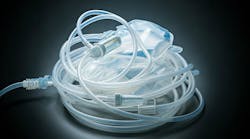Products, markets, regulators and patients are making new demands on pharmaceutical and medical device supply chains, from the factory floor to the bedside, and these demands are increasing at an accelerating rate. For example, McKinsey’s proprietary POBOS benchmarks suggest that complexity, as defined by number of SKUs per packaging line, has increased by more than 50% over the last 5 years. The industry’s current supply chain model will not be able to meet these challenges forever, forcing companies in the sector to develop new capabilities and new ways of working in order to transform speed, efficiency, flexibility and reliability across the entire value chain.
Better supply chains won’t just allow pharma and medical device companies to tackle the issues they face today. Higher supply chain performance has significant and strategic benefits for pharma and medical device companies. First, it can reduce costs, by shortening manufacturing lead times, slashing inventory levels across the value chain, and cutting product obsolescence. Second, it can improve access, reducing drug and device shortages in developed markets and delivering affordable healthcare to millions more people in emerging markets. Third, it can transform safety, by making it harder for counterfeit products to enter the supply chain and reducing the human and financial toll of medication errors.
We estimate that end-to-end supply chain expenses (including conversion cost, warehousing and distribution, inventory carrying cost and obsolescence cost) now represent nearly 25% of the pharma value chain costs and more than 40% of the medical device value chain costs. The annual spending is so vast — about $230 billion in pharma and $122 billion in medical devices — that even minor efficiency gains could free up billions of dollars for investments in other areas. Our analysis suggests that, just by adopting some straightforward supply chain advances that are already well established in other industries, the healthcare sector has the potential to improve its margins by $130 billion. With greater collaboration across the value chain, the impact of supply chain innovation in healthcare could be even larger.
A New Healthcare Supply Chain
A typical Asian laptop manufacturer can accept an order on a Monday and deliver a pallet of freshly assembled computers to a European customer on Tuesday of the following week.1 A typical pharmaceutical manufacturer can take an order for blister packs of pills and deliver them in about 75 days.
How can medical device and pharmaceutical manufacturers develop the superior supply chain capabilities currently enjoyed by fast moving consumer goods companies or consumer electronics manufacturers? We have found that most need to strengthen capabilities in five key areas: segmentation, speed, measurement, alignment and collaboration.
The first three of these are “internal” capabilities that companies can develop by themselves. The last two, potentially the most powerful, require them to work together with their customers, their suppliers and even their competitors.
1. Segmentation. Many pharma and medical device companies are close to running one-size-fits-all supply chains. Where they do differentiate between product lines, it is often only for cold-chain products. In practice, however, profitability, value density, demand variability, criticality to patients and the cost and service expectations of customers can all vary significantly. These differences can have a profound effect on the optimum planning, production, inventory carrying and logistics processes for different products, markets and customer groups.
Leading companies, in the healthcare sector and others, are now tackling these problems by intelligently segmenting their supply chains according to differing product characteristics and customer requirements. They then develop appropriate forecasting, production, inventory and distribution strategies for each category.
2. Speed. In the changing pharma and medical device environment, using high inventory levels to maintain service is becoming a costly and ineffective approach, but it is still the one adopted by the majority of healthcare players. Typical replenishment times in the sector are around 75 days, with the best pharma players achieving 30. High inventory levels hide other problems, too, reducing the incentive to improve manufacturing efficiency and leaving companies with large quantities of obsolete or defective stock on their hands when things go wrong. Our research shows that obsolescence alone wastes $51 billion globally per year across the healthcare sector, for example (mainly at providers and manufacturers).
There is plenty that companies can do today, even with existing manufacturing processes, to greatly improve their supply chain speed. Closer collaboration with customers can help improve forecasting and provide better transparency of real demand. Sharing forecast data with suppliers can help too, ensuring that production is not delayed by shortages of packaging materials, for example. Companies can increase their production frequency, shifting the average for a majority of their SKUs in packaging from once in 2-3 months to once every 2 weeks, for example. This can go along with shortening the “frozen” planning windows from 3 months to 3 weeks, allowing faster market supply and best use of available demand data. In addition, optimum selection of routes, transport modes and delivery frequencies can accelerate the movement of product between production sites, regional distribution centers and end customers.
3. Measurement. Any systematic attempt to improve a business process requires companies to understand their current level of performance. Many pharmaceutical manufacturers still struggle to obtain sufficient transparency on supply chain metrics, however. The challenges are diverse, including a lack of standard definition of key metrics, different calculation approaches in local systems, and a lack of central data transparency. While metrics like inventory reach, forecast accuracy, and customer service level are mostly available, there is a particular need to improve the transparency of key structural drivers or capabilities. Responsiveness (for example, replenishment lead time); manufacturing frequency; supply reliability (shown by production or supplier service level); and stability (for instance, share of rush orders, planning accuracy) are often not systematically measured or managed across the network.
Another area where transparency can translate into bottom-line benefits is cost-to-serve. Pharmacos need to build transparency on their total cost of supply, including conversion, transport (inbound, interplant, primary/secondary distribution), warehousing, inventory holding, staff and obsolescence. This enables both operational cost savings and optimization of route-to-market approaches and product portfolios.
Performance transparency is a key building block on the journey to a new healthcare supply chain. Upping the game isn’t just about IT investments. It requires particular attention to cross-functional alignment and operational discipline.
4. Alignment. Imagine a future where manufacturers could monitor real-time patient demand changes and shift their production schedules accordingly; hospitals and pharmacies knew exactly where short-supply devices and drugs are and when they would be delivered; and regulators could recall adulterated products with accuracy from every point in the supply chain. Unfortunately, in today’s world, manufacturers and their trading partners struggle to deliver “perfect orders” and spend countless hours chasing down errors in financial transactions and cleaning up the orders they receive from customers.
The healthcare industry must align around a single set of global data standards that support the processes and capabilities required to cost-effectively achieve the kinds of benefits we describe in this article. The grocery industry has demonstrated the value of this kind of global data standards alignment with its adoption of GS1 standard barcodes, a change which was nothing short of revolutionary and has created billions of dollars in value. While new processes, tools and systems were required to deliver this value, data standards were a critical prerequisite. The healthcare industry is still to adopt a common global data standard, but that may have to change if the industry wants to reap similar benefits as in the grocery sector. Without a single, global data standard, tackling the challenges of product complexity, global reach and improved supply chain safety and security will be significantly more costly and difficult for pharmaceutical and medical device companies.
5. Collaboration. Effective, transparent communication through the use of common standards is part of the challenge for true end-to-end supply chain integration, but as in other sectors, different players in the supply chain need to find ways to collaborate more effectively on the basis of that data in order to reap the full potential benefits.
For example, when two channel partners in the healthcare industry embarked on a recent collaborative project to improve supply chain performance, they were able to identify opportunities to reduce their joint inventory by 20 percent while still increasing service levels enough to deliver a predicted 1% increase in revenues.
Often, the key barriers to such collaboration are not technical, but cultural. In the example above, just getting to the collaboration table was the most significant challenge for the two companies, which had previously had a primarily transactional relationship. Making the collaboration work required great care in determining how it would be managed and how benefits would be shared, with considerable involvement from senior managers to overcome roadblocks. But as a result of the process, the two companies now enjoy a closer and more open working relationship, laying the foundations for future collaborations in other areas.
Many companies struggle to create any significant impact in their efforts to improve supply chain performance because they limit their change efforts to functional silos, like manufacturing, warehousing or logistics. In practice, the supply chain function is one of the most cross functional of all business processes, and any attempt to drive improvement must also be cross functional in nature. The most successful supply chain improvement efforts make strenuous efforts to overcome the problem of local optimization, often by using an integrated “control tower” approach, in which a small group of leaders from across the organization work closely together to identify opportunities for performance improvement and to capture them by driving change quickly though the entire organization.2 One company that had initially failed at reducing inventory, subsequently achieved 23% inventory reduction while improving service levels with this approach.
In 1975, the business case for barcodes in the grocery business estimated the annual benefits to the industry at $400 million. Twenty years later, research showed that the benefits exceeded $16 billion3, thanks in part to almost universal adoption of barcode standards and the enormous value of point-of-sale data gathered and shared electronically.
Given the synergies of teamwork, technology and imagination, the global healthcare system is likely to benefit from advances we can’t foresee today, just as the grocery industry has from what began as an approach to speeding checkouts.
About the Authors:
Thomas Ebel ([email protected]) , Katy George ([email protected]), Erik Larsen ([email protected]) and Ketan Shah ([email protected]) are leaders in McKinsey & Company’s Pharmaceutical Operations practice.
Resources:
1. Evaluate, CPAT, BMI, OECD, EFPIA, HRI, Espicom corporate reporting; POBOS, McKinsey analysis.
2. “17 Billion Reasons to Say Thanks: The 25th Anniversary of the UPS and Its Impact on the Grocery Industry” (PWC, 1999)
3. “17 Billion Reasons to Say Thanks: The 25th Anniversary of the UPS and Its Impact on the Grocery Industry” (PWC, 1999)





